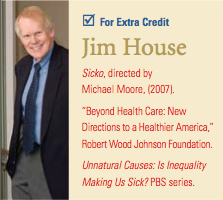Professor Jim House is on a research leave this year as a visiting scholar at the Russell Sage Foundation in New York City. From his office on the Upper East Side of Manhattan, he's writing a new book, tentatively titled Beyond Sicko and Health Care Reform, which explores the connections between education, income, employment policies, and public health. An extension of a conference and edited volume supported by the Russell Sage Foundation and the Ford School's National Poverty Center several years ago, House's book will take an integrative look at how policies designed to address social and economic concerns can have a big impact on the health of the people they touch.
 |
|
Jim House |
"The best-known fact about American health care and health policy is that we spend way more than anyone else in the world on health care and insurance—increasingly so since the mid-20th century," says House, one of 96 Distinguished University Professors at U-M since 1947, and one of three currently on the Ford School faculty. The problem is that our returns on these investments (as measured by indicators like longevity and infant and maternal mortality) have diminished relative to all other comparably developed countries, and even some developing ones. "Health has been getting better in the overall population," says House, "and this is true around the world. But we're getting a relatively poor return compared to what we're spending."
What's the fix? What can we do about it? Health care reform is intended to tackle this problem, but it can't do it alone."The people doing health care reform, in the most extensive way it's been done in the last half century, would like to believe that what they're doing will change all that," says House. But while House agrees that efforts to control and manage a program that consumes close to 20 percent of the GDP are worthwhile, he points out that these are supply-side solutions that aim to control the amount, type, price, accessibility, and quality of care and insurance. The other side of the equation—the demand side—needs to be addressed, as well.
On the demand side, there's a clear consensus that health care is not the only or main determinant of population health, and probably never has been, House explains. Rather, health is also a result of a wide range of life and work conditions, including health behaviors, environmental exposures, stress and resources for adapting to stress, and more. Exposure to and experience with all of these (and of biomedical risk factors as well) are also heavily influenced by race, ethnicity, and socioeconomic position. For example, explains House, "People who are better educated have considerably better trajectories of health over their entire life course, increasingly so over the last quarter century. And education also improves economic wellbeing and job competitiveness. Thus, investing in education improves long-term health, probably more than investing in health care at and beyond the levels that we do now."
Foundations like Russell Sage and, especially, Robert Wood Johnson are beginning to study and promote this demand-side approach. The Obama Administration is showing an interest as well. House's book—which he hopes to complete this year—will be a strong addition to the available literature on using social and economic policies to boost public health, and ultimately reduce the need for and expense of health care and insurance.
Below is a formatted version of this article from State & Hill, the magazine of the Ford School. View the entire Fall 2010 State & Hill here.